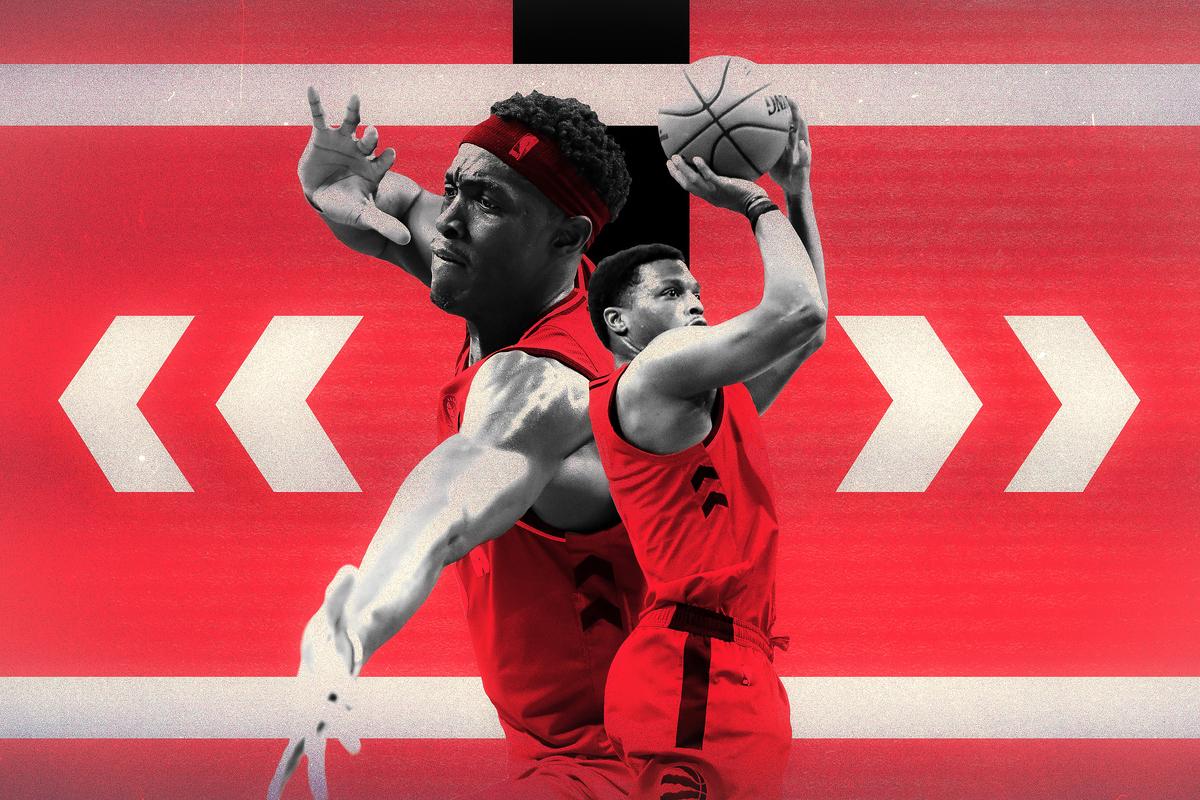
The Raptors have replaced stars with synergy. Their incredible success in the past two seasons is based on one underlying principle: Everyone in their rotation can shoot 3s and play defense. It might not sound that complicated. But no one else in the NBA has been able to do it.
Their ability to win without Kawhi Leonard shouldn’t be that surprising. They went 17-5 without him last season. No player is indispensable in coach Nick Nurse’s system. Toronto is currently the second seed in the East (48-18) and has the fourth-highest net rating in the NBA (plus-6.4) even though nearly all of its rotation players have missed significant time with injury. But with everyone healthy for the first time all season, the Raptors have emerged as an intriguing contender.
It all starts with 3-point shooting. A healthy version of the Raptors spaces the floor perfectly the entire game. Their top eight players in total minutes all attempt at least 3.3 3s per game while shooting higher than 35.9 percent. Everyone is a threat from long range. The defense can’t leave anyone open. Toronto doesn’t have the normal trade-off between volume and efficiency at the 3-point line, either. They rank seventh in the NBA in attempts (36.9 per game) and are tied for third in percentage (37.4).
Look at how playing five-out basketball allows them to spread out the Lakers (the no. 3 defense in the NBA) and keep the ball moving around the court over and over again until they create an open 3:
Playing in that much space is a booster shot for everyone. There are more driving lanes to the rim and more passing lanes when the defense rotates. It’s like batting at Coors Field.
Serge Ibaka and OG Anunoby aren’t known for their slashing ability. But it’s a lot easier to get to the rim when you have to beat only one defender and the help defense has to come from so far away:
Most NBA teams play four shooters around one big man to space the floor. Some, like Houston, invert the normal relationship so that the center plays beyond the 3-point line to create space for a non-shooter like Russell Westbrook. Toronto is one of only two teams who play five shooters the entire game. The other is Dallas, which has the top offense of all time. They both split playing time at center between two stretch big men—Marc Gasol and Ibaka for the Raptors and Kristaps Porzingis and Maxi Kleber for the Mavs. But that’s where the similarities end.
Dallas doubles down on offense at the cost of its defense, which ranks 17th in the league. Toronto has the 12th-ranked offense and second-ranked defense. The Raptors use their floor spacing to get away with playing five elite defenders. Their offense just has to be good enough so they can win with their defense. That’s why they haven’t needed an MVP-caliber player to replace Kawhi this season. They just needed a similar defensive player who could space the floor, which they already have in Anunoby.
The Raptors have no weak links on defense. Gasol and Ibaka are great rim protectors, while Anunoby, Pascal Siakam, and Norm Powell are three of the most athletic wings in the league, and Kyle Lowry and Fred VanVleet are powerfully built ball hawks who play much bigger than their size. It’s tough to beat any team when all of its shooters can play defense, too.
But Toronto doesn’t sit back and play conservative defense, either. The key to winning games on that side of the ball is to force the issue and take away the strengths of opponents. Nurse loves to attack the very weakness that his own offense doesn’t have. No other team in the NBA is more aggressive about doubling the ball and forcing it into the hands of non-shooters; one example is the box-and-one they used on Steph Curry in last year’s Finals.
Toronto’s 107-92 victory against the Lakers on Saturday is a great example of its game plan in action. The Raptors held LeBron James and Anthony Davis to 34 points on 9-of-22 shooting, far below their combined season average of 52.2 points on 37.6 field goal attempts per game. Their help defense forced the ball away from L.A.’s stars to its supporting cast, which combined to shoot 10-of-40 from 3. Look at the way the ball ends up in the hands of players like JaVale McGee (1-for-3) and Markieff Morris (3-for-10):
There is also some luck involved. Toronto allows the second-most 3-pointers per game (38.6), yet leads the league in defensive 3-point percentage (33.6). Milwaukee has made a similar calculation in terms of conceding 3s to protect the rim, but is 15th in percentage allowed. There’s only so much any defense can do to control whether opponents make 3s.
But the Raptors do a lot of things right. They have the teamwide length and athleticism to cover ground on the help side as well as the basketball IQ to understand opposing personnel and funnel the ball into the wrong hands. This is a well-coached team that can execute complicated schemes and play defense on a string. Nurse, a coaching lifer with experience all over the world before coming to the NBA, is the favorite to win Coach of the Year for a reason.
But his job is also easier than his peers’ jobs because he doesn’t have to make trade-offs between shooting and defense. He has a deep bench of players who can play at both ends. Terence Davis, an undrafted free agent who has been one of the best rookies in the league this season, provides an unusual combination of elite athleticism and shooting. Now that everyone is healthy, the key rotation question for Nurse is whether his eighth man should be Davis or Patrick McCaw, who is a longer, more savvy defender but a more reluctant outside shooter. Even playing one non-shooter can really hurt the team. The Raptors have a net rating of plus-9.1 in 1,104 minutes with Davis this season, but just plus-0.6 in 908 minutes with McCaw.
The synergy between their defense and offense creates a virtuous cycle. Getting stops allows Toronto to play in transition, and scoring in transition allows the team to set its defense and force opponents to play in the half court. The Raptors are top in the NBA in transition possessions per game (24.3) and third in points per possession on those plays (1.17).
They have discovered a cheat code when it comes to replacing stars. Increase the usage rate for a good player on a team with great floor spacing and great defense and you can turn him into a great one. Toronto doesn’t need stars because its style of play creates them.
Look at Siakam this season. He made his first All-Star Game largely because his role changed following Kawhi’s departure. Siakam went from averaging 16.9 points per game on 54.9 percent shooting to 23.5 points on 45.7 percent shooting. His scoring went up and his efficiency went down because his number of field goal attempts skyrocketed from 11.8 to 18.7.
To be sure, Siakam put in an incredible amount of work in his first four seasons in the NBA, especially as a shooter, winning Most Improved Player last season. But he’s still not a great offensive player despite playing in so much space in Toronto. He has the lowest true shooting percentage (55.8) and third-lowest assist average (3.6 per game) of the 10 All-Star starters. He’s considered one of the NBA’s best players because he’s the leading scorer on an elite team. There’s a bit of circular logic at work when we evaluate players. We think the best teams need All-Stars to win while we give All-Star berths to the players on winning teams.
The question for Toronto is how far can it go in the playoffs without a genuine superstar like Kawhi. The Raptors’ success is based on exploiting weaknesses. They are 35-4 against below-.500 teams this season and 13-14 against everyone else. There aren’t many weaknesses to attack in the later rounds of the playoffs. A natural process of attrition forces teams to change their rotations. The Lakers’ starting lineup was minus-10 in 10 minutes on Saturday. But starting McGee is just a way to buy time before they downsize and play much better lineups with Davis at the 5 in the playoffs.
There comes a point when teams need their best players to raise the level of play of their supporting cast. That’s what happened in the 2019 Eastern Conference finals. Toronto was every bit as deep and balanced as it is this season, and Giannis Antetokounmpo still ran them off the floor in the first two games of the series. Everything changed when Kawhi stepped up and switched onto Giannis in Game 3. Can Siakam do the same?
Toronto probably needs someone like Kawhi or Giannis to win a title. But a team with a formula to create stars will be able to land a superstar eventually. They can either trade a couple of their own players for one like they did with Leonard, or put together an attractive team to lure a superstar in free agency.
They are in a great position moving forward, with as much future flexibility as any team in the NBA. Siakam is their only player under contract past 2022. GM Masai Ujiri is a natural salesman who can make a compelling pitch to Giannis in the summer of 2021. He’s already shown that he knows how to build the perfect supporting cast. And if it’s not Giannis, then it will be someone else. The Raptors are always in position to strike when a superstar becomes available. They did it with Kawhi two summers ago. They will do it again.

